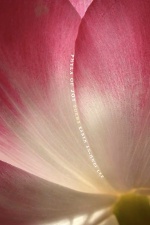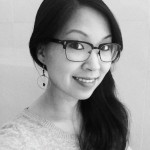
A Guest Post by Eugenia Leigh
Phyla of Joy by Karen An-Hwei Lee | Tupelo Press 2012 | $16.95

When entering Karen An-hwei Lee’s mysterious world of silver eucalyptus groves and Holy Spirits, the temptation is to dissociate. To keep that ethereal realm separate from the mud-and-waste Earth most of us know. But Lee’s power lies in her ability to unite both worlds. Instead of distancing the Divine from cigarettes and kitchen fires, Lee welcomes the one into the other. But the startling result isn’t a third world tangled with dichotomies. The result is Phyla of Joy, a portrait of the world we live in, but reclaimed through gracious eyes that somehow inject light into everything from famine to girls born with cleft palates.
Lee prepares her reader for this new world with her epigraphs, the first of which comes from a Davidic psalm: “For with You is the fountain of life; / in Your light we see light.” Immediately, the following formula is established: to find light on Earth, Lee’s poems—and we readers—will need to rely on the light of the divine “You.”
This “formula” seems simple enough, but how much effort does it really take for our generally afflicted human selves to seek out that otherworldly light? Lee addresses that tension between being human and craving something beyond-human in the book’s first poem, “Yingri.” In the Tupelo Press reader’s companion to Phyla of Joy, she notes that yingri is a Chinese word composed of two characters. While Lee tells us that the second character translates to “sun,” she allows the meaning of the first character to remain ambiguous in its multiple possible translations: “shadow,” “eagle,” “to reflect.”
The poem’s two stanzas add to our understanding of yingri’s duality. The first stanza, representative of earth and ying with its many meanings, reads:
Inside me is a bridge, or the beams of a house,
and an old ground swell beneath a garden boat.
The speaker’s observations in this stanza reflect the multiple meanings of ying with the word “or,” which reveals both the speaker’s uncertain sense of her human self and also the possibility of additional manmade constructions buried within her.
The second stanza constitutes ri—the sun and its associations with divinity:
Outside, on an acre of snow,
a winter sun, blinding.
What appears to be a small, four-line opening poem speaks volumes when pitted against the rest of the collection. We asked earlier how people can invite supernatural light into a worldly existence. And here is the answer: by blinding.
In order to see, we must first be blind, insists Lee. And sure enough, after a number of poems that refer to blindness, we meet a blind woman “typ[ing] out letters twice” in “Sweet Glossolalia.” The blind woman suddenly takes control of the poem’s narrative, as each image begins to reflect her experience. The setting, for example, is perforated with punctuation-related diction, which draws us into a backdrop that melds the woman’s typing with the scenery: “Bravura of light, one apostrophe. / Red flowers or commas in a square.” Strong sounds also overpower the poem’s images as if to communicate the blind woman’s heightened sense of hearing. The punching assonance of “Hot at two o’clock. / Potted tea sun” is chased by the slicing assonance of “at the sink, thin as new hat pins / or tin silence.”
In the final three lines of this 29-line poem, Lee steers us in a surprising direction by introducing a first-person speaker. The “I” simply “open[s] a letter,” and although we readers might be alarmed by her unexpected appearance, the blind woman does not flinch. Instead, she speaks her first words of the book—a command—directed toward this speaker whose presence hardly stirs her: “Open quietly.”
The blind woman’s firm directive suggests that she is a person of authority, and the aura of her authority only grows as she becomes a recurring character in Phyla of Joy. In a number of subsequent poems, most of which appear in the book’s second section, we follow her through her world and learn to ‘see’ as she sees. We tag along as the “blind woman presses scriptural flowers into street hands.” We’re privy to her thoughts as she “consider[s] the inverted thinness of cigarette paper, almost fish skin or petal.”
In the prose poem “Ounce of Camphor,” the blind woman even begins to interact with the omniscient voice that narrates Lee’s poems, although the overarching “speaker” of this poem is not identified in the first person. The blind woman once again co-opts the narrator’s voice, similarly to the way she asserts authority over the “I” in “Sweet Glossolalia.” The speaker of “Ounce of Camphor” first unravels layers of observations: “a three-stringed balalaika is tuned in fourths. A man with a bleeding face jumps into a truck and drives away.” But when the voice, touching on the surreal in a language that is quintessential to Lee’s inventive images, declares, “Invisible blue lines embrace the world, sightless meridians,” the blind woman stops her. She questions the integrity of the statement, asking, “If they’re invisible, how do you know they’re blue.”
Because of the lack of a first-person “I” in this poem, we’re led to believe that the blind woman is not only questioning an amorphous, anonymous speaker, but also questioning the poet herself. In a striking act of humility, Lee yields control of her poem to this character, only for her to point back at the poet and critique her words.
The blind woman’s display of increasing power also leads us to wonder whether she is serving as an incarnation of the “You” from the book’s epigraph: the “You” in whose light we see light.
Even when the blind woman is absent, Lee’s poems are shaped by an ability to “see” beyond what can be processed with eyesight. For example, in “Prayer for a Bamboo-Flowering Famine,” Lee addresses a famine that occurs in parts of India every 50 years because of the flowering of bamboo, which triggers a plague of rats that destroy the region’s crops. But instead of reporting the facts of this famine, Lee rejects the famine’s power by visualizing and claiming an alternate, unseen reality in which the bamboo and the rats do not harm the land.
While the blind woman teaches us to ‘see’ beyond what our eyes catch, here Lee’s poet-as-speaker teaches us what to do with our newfound ability of otherworldly sight—summon our prophetic visions into reality through prayer:
May we blossom every fifty years
without afflicting the people.
. . .
May our shoots
pray a silent vision of healing,
. . .
Let us bless our fruit and multiply.
The word “may”—as it is used in an imperative statement instead of in a question—contains an authoritative power. The strength of these pronouncements, piled one on top of the other, give the sense that this idealized world of non-destructive bamboo flowers can transcend hope to become reality. Lee’s prayer-poem is one that introduces hope not as “wish,” but as “certainty.” Her syntax, climaxing in a final command-like last line—“Let us bless our fruit and multiply”—reveals that the speaker believes she possesses the power necessary to create this new world by speaking it into being through prayer. She does not pray to her deity with timid requests. She issues imperative statements.
If Lee intends to allude to this power of creation, then the ramifications of this message reach beyond the poem and into the social context of our contemporary era of tumult and impermanence. In “Prayer for a Bamboo-Flowering Famine,” Lee embodies the voice of the bamboo in the plural first person, which allows us to interpret the prayer/invocation as a metaphor for a reality that belongs not only to bamboo, but also to people. In doing so, she passes on the vision that the blind woman has passed on to her. She encourages us to “see” beyond present circumstances and into the possibility of a redemptive world created through the declaration of truths that can be spoken into being through prayers.
Phyla of Joy is an invitation, and that invitation is two-fold in process. First, Lee introduces us to the world of the blind woman, who “sees” what sighted people otherwise might not catch. But the magic in these poems comes from the second invitation: for us not only to observe, but also to partake in the blind woman’s sight. To set aside our eyes. To walk into willing blindness. And receive the light that comes when we are able to envision the possibilities beyond our present “visible” situations, and harness our words to cement those possibilities in reality.
* * *
Eugenia Leigh is a Kundiman fellow and the author of a forthcoming collection of poetry, Blood, Sparrows and Sparrows (Four Way Books, 2014), which was a finalist for both the National Poetry Series and the Yale Series of Younger Poets. She holds an MFA from Sarah Lawrence College, and lives in New York City, where she believes in miracles.
2 thoughts on “Review: Karen An-Hwei Lee’s PHYLA OF JOY”